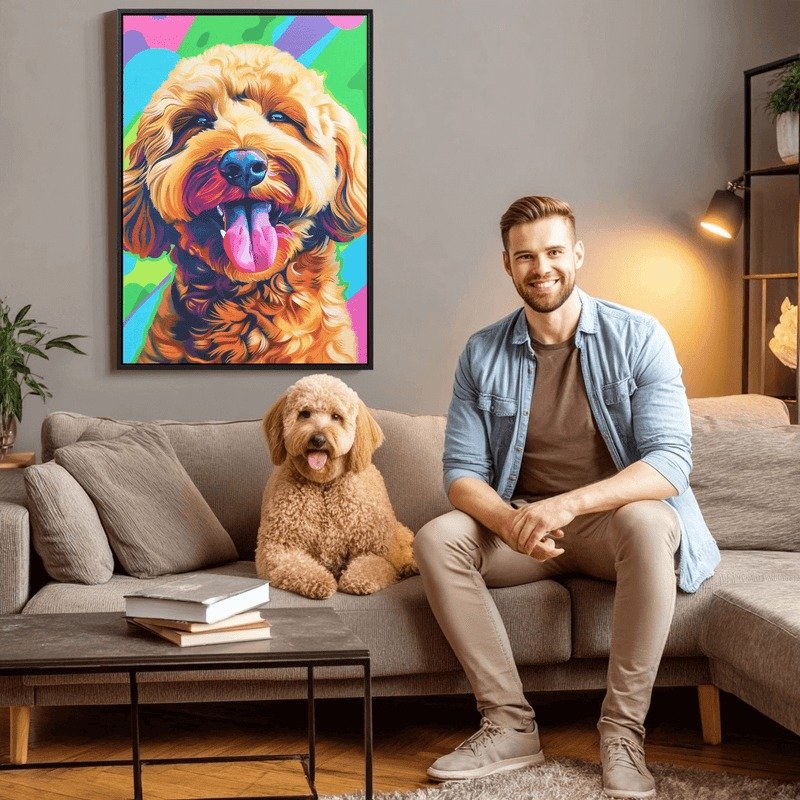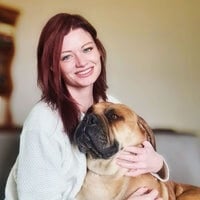
A dog whale eye or side eye is a term used to describe when a dog turns their head to look at something or someone through their peripheral vision. This behavior is often seen when a dog is feeling uncomfortable or anxious in a situation. It is also one of the most common early warning signs of aggression that dog owners miss sometimes months before a dog finally growls or bites.
Paying attention to your dog’s physical eye health, such as by regularly cleaning them with canine eye wipes is vital. But the eyes are also how your dog communicates with you. When a dog exhibits whale eyes, it is important to pay attention to their body language and behavior. Dogs may display other signs of stress or anxiety, such as a tucked tail, tense closed mouth, yawning, lip licking, and ears pinned back. If a dog is exhibiting whale eye, it is best to give them space and avoid approaching them until they have calmed down.
Understanding dog whale eye and its associated behaviors can help dog owners and caretakers better communicate with their furry friends. By recognizing the signs of stress and anxiety, individuals can take steps to alleviate their dog’s discomfort and provide a safe and comfortable environment for them. To really get into this topic, we will consult Dr. Bonnie Beaver and dog trainer Brenda Aloff[1] to get into why dogs really give us the side eye.
Table of Contents
- So, What is a Dog Whale Eye or Side Eye?
- A Warning About A Dog Side Eye or Whale Eye
- What Causes A Dog To Give You A Whale Eye (Side Eye)?
- Understanding Dog Eye Body Language
- What do You Do When a Dog Gives You a Whale Eye?
- How Do You Stop Whale Eyes in Dogs?
- Frequently Asked Questions (FAQs)
- Conclusion
- References
So, What is a Dog Whale Eye or Side Eye?
Dog whale eye is a phenomenon that occurs when a person can see the whites of a dog’s eye. It is often accompanied by a side eye, where the dog turns its head to look at someone from the side, allowing the whites of their eyes to become visible. This behavior is typically associated with anxiety, stress, uncertainty, pain, discomfort, fear, or even aggression.
The most notable feature of a dog whale eye is the visible white portion of the eye, which is also known as the sclera. This occurs when the dog turns their head while keeping their eyes fixed on the object of their concern. The result is a sideways glance that exposes the white of the eye, giving the impression of a whale’s eye.
It is important to note that a dog whale eye is not always a sign of looming aggression. It is usually a sign of fear, uncertainty, or discomfort, but a side eye from a dog can turn into aggression when it’s ignored and somebody continues to invade a dog’s space or put them in a pressured situation. It is crucial to observe the dog’s body language and other cues to determine the underlying cause of this behavior.
A Warning About A Dog Side Eye or Whale Eye

A side eye of a whale eye is a dog’s way of politely saying, “I am anxious and uncomfortable about this. Please stop doing it.”
And no, it doesn’t matter if all you are doing is petting the dog and trying to show them love. Dogs have a right to feel uncomfortable with physical touch just like humans dogs, and they often do. Just like humans, dog’s don’t always want to be touched; they don’t always want someone up close in their personal space, or they may not like being touched in specific areas, such as their paws. This can all warrant a side eye.
When people ignore a dog’s side eye for long enough, a dog may start to escalate their behavior to try to get space. This is not always the case, but over time, a whale eye can turn into a raised lip, which can turn into a snarl, which can turn into a nip, which can turn into a bite. It is usually only at the bite stage that people start to take their dog’s request for space seriously.
It is true most dogs don’t escalate from a side eye to a bite, because most dogs have instinctive bite inhibition[2] that keeps them from biting people even when they want to. But this still doesn’t mean that it’s okay to ignore the whale eye and continue to cause a dog stress.
In the video below, a man pets his angry Chihuahua for comedic reasons. Since it is a small dog, the aggression is considered funny, which is not how the same attitude most people would have a Pitbull. As the Chihuahua begins to bite their owner, note that the whites of their eyes are showing. This is enough of a signal that the dog feels stressed by the interaction and does not want to be petted.
Viewed through this lens, the interaction becomes a lot less funny. In the next video, you can see the same whale in a dog that does not want to be touched. You can see he starts with the whale eye, then the growl, then starts to bite to ask the owner to remove their hand.
Note: I strongly do notrecommend doing what this owner is doing below, especially with a more powerful dog whose bite could do more damage. The technique shown in this video to stop the dog growling could lead to serious injury if you are dealing with a Rottweiler or Pitbull. There are much kinder, safer, and easier ways to get a dog comfortable with being touched.
In the above video, the side eye was a precursor to aggression. However, it is really a sign of stress and fear. Most dogs who give a whale eye will not bite, it’s simply important to note that the dog is feeling anxious and fearful.
Dog whale eye can be seen in various situations, such as when a dog is meeting a new person or animal, when they are in an unfamiliar environment, or when they feel threatened or intimidated. It is essential to approach dogs exhibiting this behavior with caution and give them space to feel comfortable.
What Causes A Dog To Give You A Whale Eye (Side Eye)?

Dogs communicate through body language, and their eyes are one of the most expressive parts of their body. A side eye or whale eye is a common behavior that dogs exhibit when they are feeling uneasy or uncomfortable. Understanding what a side eye or whale eye means is crucial for dog owners to ensure their pet’s well-being.
1. Anxiety, Fear, and Stress

A side eye or whale eye can indicate that a dog is anxious or stressed. Dogs may show this behavior when they are in new or unfamiliar surroundings, or when they are meeting new people or animals. They may also display this behavior when they are in a situation that they perceive as threatening or scary.
When a dog is showing a whale eye because of fear or anxiety, you will may also see other discomfort signs:
- Lip licking;
- A stress yawn;
- A tail held low or tucked;
- Licking their nose;
- Crouching or cowering;
- Averting their gaze or turning their head away from you; and
- A kiss to dismiss behavior (where a dog briefly licks your face before turning their head away to say “I like you but please go away, see: why does my dog lick my nose).
When these early signs are ignored, they may turn into aggression to try to push you or the threat away and create distance.
2. Discomfort in the Environment
Dogs may exhibit a side eye when they are simply in an environment that makes them uncomfortable. Examples of when dogs give the whale eye from environmental discomfort includes:
- During fireworks or thunderstorms;
- During a noisy house party when the house is filled with strangers or unfamiliar and loud children;
- When there is conflict in the home, such as when people are fighting (human fights stress dogs out too);
- When there is something disruptive going on, such as loud construction; and
- Or anything else in the environment that may be causing your dog stress.
3. Aggression
A side eye or whale eye can also be a sign of aggression, although it is usually fear-based aggression or resource-guarding (aggression over food, a favorite person, or other high-value object) rather than true aggression. When a dog is feeling threatened they may show this behavior. Unfortunately, because showing the whites of the eye is so subtle, many people miss this early warning sign.
When a side-eye starts becoming aggressive, it is part of a distancing behavior. In other words, it is one of several behaviors your dog will use to create distance between themselves and the threat. You may also see:
- A tight, tense body;
- A stiff tail;
- Raised hackles;
- Lifting the lip to show teeth;
- A growl or snarl;
- Lunging or snapping;
- Nipping; and
- And finally biting.
It’s important to understand that your dog is not doing this to show dominance or because they are bad dogs. It typically only escalates when people ignore the early signs of discomfort and the dog feels out of options and needs to escalate their behavior to get the space they want. This is also often how children may be bitten, as children will often be left to play with a dog’s food while they are eating or climb in their crate, and kids will simply not interpret the early warning signs.
4. Nervousness
Dogs may display a side eye or whale eye when they are feeling nervous. This could be due to a variety of reasons, such as loud noises or sudden movements. Dogs may also show this behavior when they are meeting new people or animals.

Turn Your Pet's Photo Into Canvas Art
Upload a favorite photo and our artists craft a custom portrait in your choice of style - Abstract, Cubism, Pop Art, Whimsical, Gravity, Picasso and more. Unlimited revisions until you love it.
Shop Now 👉Perfect Portrait Guarantee • Unlimited Revisions
5. Pain or Illness
A side eye or whale eye can also indicate that a dog is in pain or ill. Dogs may show this behavior when they are experiencing discomfort or when they are feeling sick. Typically the whale eye is used when the dog is scared that you will touch an area on their body that hurts.
6. Appeasement (When Owner Seems Angry)
Dogs may exhibit a side eye or whale eye when they are trying to appease their owner. This behavior can occur when the owner is angry or upset with the dog. Dogs may display this behavior as a way to calm their owner down. People often confuse this with a “guilty” look when a dog has done something wrong. In reality, dogs don’t understand when they have done something wrong, they are just reacting nervously to your anger.
When dogs look “guilty” when their owner is chastising them, they often give a whale eye, where you can see the whites of their eye. Other signs of stress include:
- Looking away;
- Lowering the head;
- Lips drawn tight and tense;
- Licking lips;
- Stress yawns; and
- And pinned back ears.
7. Stress Over Resources (When People Approach a Dog’s Food, Toys, etc. Related to Resource Guarding)
Dogs may show a side eye or whale eye when they are feeling stressed over resources. This can occur when people approach their food, toys, or other items that the dog considers to be theirs. This behavior can be a sign of resource guarding, and it is important to address this behavior with training and behavior modification.
8. Distrust
A side eye or whale eye can also indicate that a dog does not trust a person or situation. Dogs may show this behavior when they are feeling uncomfortable or unsure about a person or situation. It is important to respect a dog’s boundaries and give them time to adjust to new people or situations.
In conclusion, a side eye or whale eye is a common behavior that dogs exhibit when they are feeling uneasy or uncomfortable. Understanding what this behavior means is crucial for dog owners to ensure their pet’s well-being. By being aware of your dog’s body language, you can better understand their needs and provide them with the care and attention they require.
Understanding Dog Eye Body Language

Dogs use their eyes to communicate their feelings and intentions. Understanding dog eye body language can help you interpret your dog’s behavior and respond appropriately. Along with ear positions and expressions, eye signals form a crucial part of canine communication. Here are some common dog eye behaviors and what they might mean:
The Hard Stare
A hard stare is when a dog looks directly at you without blinking. This can be a sign of aggression or dominance. If a dog is giving you a hard stare, it’s important to avoid direct eye contact and slowly back away.
The Soft Gaze
A soft gaze is when a dog looks at you with relaxed eyes. This can be a sign of affection or submission. If your dog is giving you a soft gaze, it’s a good sign that they are comfortable and happy.
Blinking
Blinking is a sign of relaxation and trust. If your dog blinks slowly while looking at you, it’s a good sign that they are comfortable and relaxed in your presence.

Choose From Multiple Artistic Styles
Bold color pop, modern geometric, playful whimsy or clean contemporary looks. Pick the vibe, preview in 1–2 days, request tweaks until it's exactly right.
Shop Now 👉Perfect Portrait Guarantee • Unlimited Revisions
Averting Gaze
Averting gaze is when a dog looks away from you. This can be a sign of fear or submission. If your dog is averting their gaze, it’s important to respect their boundaries and give them space.
Understanding dog eye body language can help you better communicate with your furry friend and build a stronger bond. By paying attention to your dog’s eyes, you can better understand their emotions and respond appropriately.
What do You Do When a Dog Gives You a Whale Eye?

When a dog gives you a whale eye, it is a sign of discomfort or anxiety. The term “whale eye” is used to describe when a dog shows the whites of their eyes, usually while keeping their head still and looking at something out of the corner of their eye. It is important to recognize this behavior and respond appropriately to avoid any potential aggression or biting.
Here are some steps to take when a dog gives you a whale eye:
-
Stop what you are doing: If you are interacting with the dog in any way, stop immediately. This could mean stopping petting the dog, moving away from the dog, or stopping any activity that may be causing the dog discomfort.
-
Give the dog space: If the dog is showing signs of discomfort, it is best to give them some space. Move away from the dog slowly and calmly, allowing them to feel more comfortable.
-
Avoid direct eye contact: Direct eye contact can be seen as a threat to dogs, especially if they are already feeling uncomfortable. It is best to avoid staring at the dog and instead look away or to the side.
-
Use calming signals: Calming signals are body language cues that can help to calm a dog down. These include yawning, blinking slowly, and turning your body to the side. Using these signals can help the dog feel more relaxed and less threatened.
-
**Rebuild Trust and build confidence: **Move back to the threshold where your dog is still comfortable. Gradually build a positive association with the “threat”. One example is to throw treats from a distance where the dog is comfortable, and then gradually decrease that distance as they grow more comfortable with your presence.
-
Seek professional help: If the dog continues to show signs of discomfort or aggression, it may be necessary to seek the help of a professional dog trainer or behaviorist. They can help to assess the situation and provide guidance on how to safely interact with the dog. Do not pressure the dog by trying to force them or show dominance or punish them. This will almost always escalate the issue. Read this article on how to discipline dogs if you are having problems with unwanted behaviors before you resort to punishments.
Overall, it is important to recognize when a dog is giving you a whale eye and respond appropriately to avoid any potential danger. By following these steps, you can help to keep yourself and the dog safe while also promoting a positive and respectful relationship.
How Do You Stop Whale Eyes in Dogs?
Identify the Trigger
The first step in stopping whale eyes in dogs is to identify the trigger. It could be a loud noise, a new environment, or a certain person or animal. Once you have identified the trigger, you can work on desensitizing your dog to it.
Provide a Safe Space
Dogs need a safe space where they can go to feel secure and calm. This could be a crate, a bed, or a designated area in your home. Make sure your dog knows where their safe space is and encourage them to go there when they feel anxious.
Use Positive Reinforcement
Positive reinforcement is a powerful tool in dog training. When your dog exhibits calm behavior, reward them with treats, praise, or playtime. This will help them associate calm behavior with positive outcomes.
Consider Professional Help
If your dog’s whale eye behavior is severe or persistent, consider seeking professional help from a veterinarian or a certified dog trainer. They can provide you with more personalized advice and techniques to help your dog overcome their anxiety.
In conclusion, stopping whale eyes in dogs requires patience, consistency, and a good understanding of your dog’s behavior. By identifying the trigger, providing a safe space, using positive reinforcement, and seeking professional help if necessary, you can help your dog feel more calm and secure in stressful situations.
Frequently Asked Questions (FAQs)

Make Your Pet The Centerpiece
Professionally rendered canvas transforms everyday snapshots into heirloom-quality wall art that celebrates personality and presence. Ready to hang.
Shop Now 👉Perfect Portrait Guarantee • Unlimited Revisions
What is whale eye in dogs?
Whale eye is a term used to describe the visible white portion of a dog’s eye, which becomes more pronounced when the dog is experiencing stress or anxiety. The term “whale eye” comes from the appearance of a whale’s eye, which also has a large visible white portion.
How can you prevent whale eye in dogs?
Preventing whale eye in dogs involves identifying and addressing the underlying cause of the stress or anxiety. This may involve reducing exposure to triggers, providing a safe and comfortable environment, and using positive reinforcement training techniques to help the dog feel more secure.
What is the difference between whale eye and side-eye in dogs?
Whale eye and side-eye are both terms used to describe the way a dog’s eyes appear when they are feeling stressed or anxious. However, side-eye refers to a dog’s tendency to look at something out of the corner of their eye, while whale eye refers specifically to the visible white portion of the eye.
Do whale eyes always indicate stress in dogs?
While whale eye is often a sign of stress or anxiety in dogs, it is not always an indicator of these emotions. Dogs may also exhibit whale eye when they are curious or alert, or when they are trying to communicate with their owner.
Can other animals exhibit whale eye?
Whale eye is not exclusive to dogs and can be observed in other animals, such as horses and primates, when they are experiencing stress or anxiety.
What is the significance of whale eye in animal behavior?
Whale eye is an important indicator of an animal’s emotional state and can help owners and trainers identify when their animal is feeling stressed or anxious. By recognizing these signs, owners can take steps to address the underlying cause and help their animal feel more comfortable and secure.
Conclusion
Seeing the white’s of a dog’s eye is a sign of stress, uncertainty, anxiety, fear, and early aggression. It is vital to pick up on this early sign of body language to prevent problems escalating.
References
- Google Books. Co. https://books.google.co.za/books?hl=en&lr=&id=QPlfDwAAQBAJ&oi=fnd&pg=PT13&dq=dog+whale+eye+or+side+eye+body+language&ots=ak2Fd1K7NJ&sig=7xWp1W4MpLFbvu3pMCQu-Aa1djQ&redir_esc=y#v=onepage&q&f=false
- Dog bite prevention - ProQuest. Proquest. https://www.proquest.com/openview/240d6b0f27fe8aa1b337037c19c7f0bd/1?pq-origsite=gscholar&cbl=2041027







